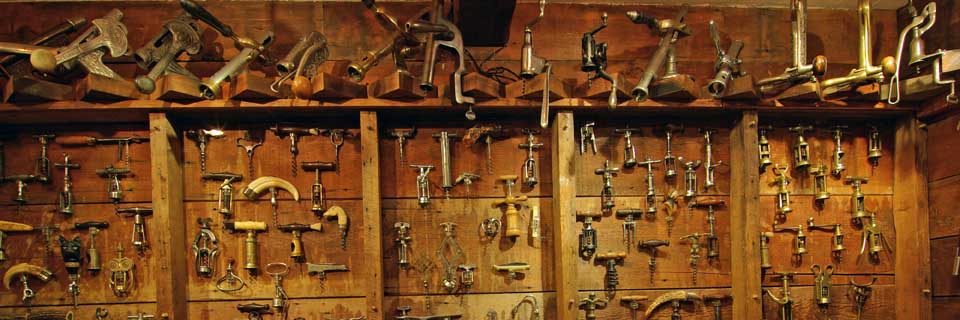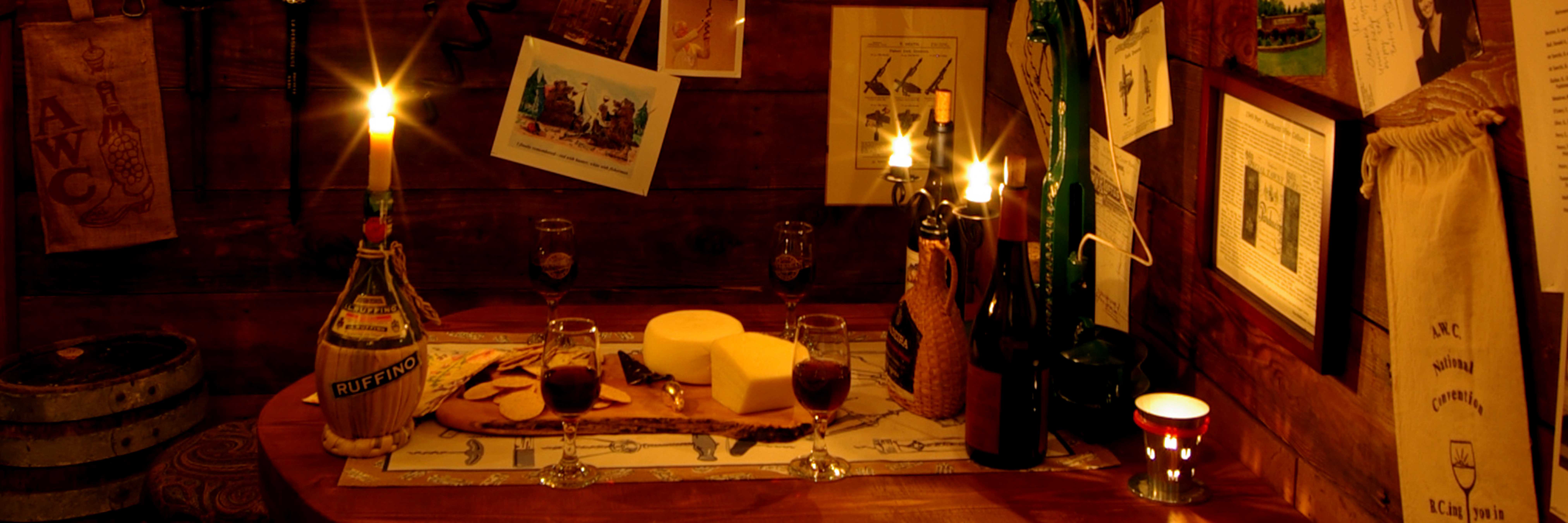


|
|
Precious metalA ladies' gold and mother of pearl pocket corkscrew made in France in the mid 19th century.French Iron CageA very early - possibly 17th century - cage from France.1862Charles Chinnock's American patent, manufactured in England.English Harp with Codd bottle openerAn unusual combination.Cotterill's 1842 PatentEdwin Cotterill of Birmingham, England invented all sorts of mechanical devices, including this "self-adjusting" corkscrew. His name is well known to lock collectors.Gun ToolMade in Germany in the late 1700's.Hampton LeverAn English corkscrew from about 1885.Brass CageA very unusual Italian cage, made late in the 18th century.Ivory CageA late 18th century cage from France.Bow-tied CatA corkscrew cane with a cat's head handle, carved in Germany's Black Forest.Molson's AleMolson's is the oldest brewery in North America. Twenty-three-year-old John Molson founded it in Montreal in 1786.German LegsUnusual in that the boots face in, this pocket corkscrew dates to about 1894.Lucky Waiter!Made in France, this is Perille's 1894 patent for a "waiter's" lever-assisted corkscrew. It is marked "Levier."French Multi-toolLong before the Swiss army knife was thought of, someone in France made this comprehensive tool. It dates to about 1750.Champagne, anyone?This elegant corkscrew was patented by Ferdinand Parfu in 1871. The blade is for cutting string.Lazy TongsThis English corkscrew is marked "Peerless" and dates to 1885.PerillePerille's 1880 patent for a lever-assisted folding corkscrew. Made in France.Hull VIIThis English corkscrew is a variant of Charles Hull's 1864 patent.Le FrançaisA French corkscrew from the late 1800's.White PatentSome of the least prepossessing designs are prized by collectors. American Joseph White patented this one in 1883.Irish CoaxerMarked "Reads Coaxer", this corkscrew was the first to use a button to assist in pulling the cork. Made in Ireland in about 1790.RÉGULATEURThe original box is hard to come by. (Only two of these are known to exist.)Syroco QuartetThe corkscrew hides in the bodies of these figures made by the Syracuse Oranmental Company.OhringA German patent from 1893, it's not so different from a today's Screwpull.Poison!Designed to be left in the cork of a medicine bottle or the container of something toxic.wHw AustriaKarl Hagenauer designed these hinged-worm pocket corkscrews when Art Deco was the style of the day in Vienna.Werkstätte Hagenauer Wien (wHw)A pack of 1920's hounds from the creative mind of Karl Hagenauer; these are the only known examples.Tinder BoxUsed with a flint to start a fire, this German tinder box dates to the late 1700's.Wooden CageA French corkscrew made from ironwood in the mid- to late-1700's.ThomasonAn extremely rare ratchet handle version of Thomason’s 1802 corkscrew. UniversalA 1907 German patent for a pocket corkscrew with a retractable sheath, marked "Universal."Snail faceA German snail face corkscrew with moveable legs to grip the bottle's neck, from about 1880.These are the Pitts!Two versions of Joseph Pitt's 1882 American patent. The smaller one is the only one we've seen.Strange ItalianA very unusual corkscrew with a brush, made in Placenza, Italy in the late 1800's.Keeping up with the JonesesThe only known example of an 1842 Robert Jones II that is fully marked on both sides, with its badge, in mint condition.More precious metalA gold and agate pocket corkscrew, circa 1750, made by James Roberts, London. |
||||||||||||||||||||||||||||||||||||||||||||||||||||||||||||||||||||||||||||||||||||||||||||||||||||||||||||||||||||||||||||||||||||||||||||||||||||||||||||||||||||||||||||||||||||||||||||||||||||||||||||||||||||||||||||||||||||||||||||||||||||||||||||||||||||||||||||||||||||||||||||||||||||||||||||||||||||||||||||||||||||||||||||||||||||||||||||||||||||||||||||||||||||||||||||||||||||||||||||||||||||||||||||||||||||||||||||||||||||||||||||||||||||||||||||||||||||||||||||||||||||||||||||||||||||||||||||||||||||||||||||||||||||||||||||||||||||||||||||||||||||||||||||||||||||||||||||||||||||||||||||||||||||||||||||||||||||||||||||||||||||||||||||||||||||||||||||||||||||||||||||||||||||||||||||||||||||||||||||||||||||||||||||||||||||||||